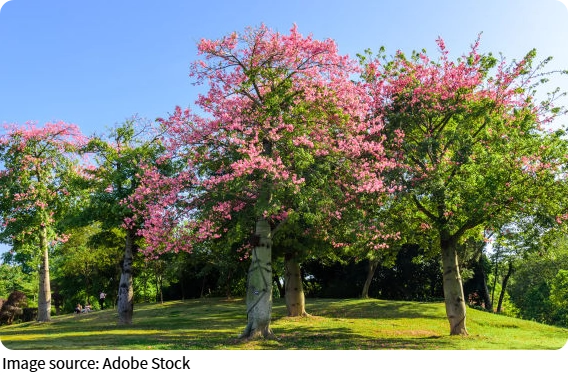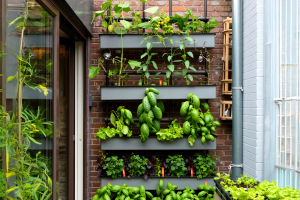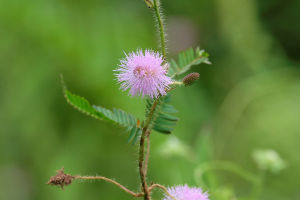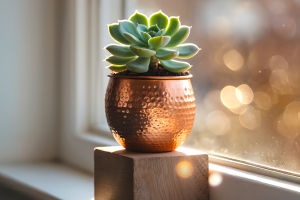Floss Tree Magic

Have you ever spotted a tree that seems to glow with pink flowers, standing tall and elegant, almost like it belongs in a fairy tale? That’s the Silk floss tree, or Ceiba speciosa.
Known for its dramatic trunk and vibrant blooms, this tree captures attention wherever it grows. Let’s explore its appearance, flowers, seeds, ecological role, and tips for enjoying it up close.
Unique and Striking Trunk
One of the first things we notice about the Silk floss tree is its trunk. It grows straight and tall, typically 8–15 meters high, and is often covered in sharp, cone-shaped spikes. These spikes are not just for show—they help protect the tree from animals. The trunk’s thick, sculptural shape gives it a bold, eye-catching presence. Branches spread upward and outward, forming a rounded canopy that provides shade and creates a beautiful silhouette against the sky.
Lush Leaves
The leaves grow in clusters at the tips of the branches, each made up of 5–7 smaller leaflets. The top surface of each leaflet is glossy green, while the underside is lighter. Leaflets are small, usually less than 1 cm long, with slightly serrated edges. The leaves create a gentle texture that contrasts with the bold, spiky trunk, adding elegance to the tree’s overall look.
Show-Stopping Flowers
The flowers are the star attraction. Blooming before or with the leaves, they appear in rich shades of pink or purple-red, with creamy white centers dotted with brown. Each flower can reach 10–15 cm in diameter, making them highly visible even from a distance. Five fused stamens wrap around the central pistil, and delicate white filaments near the base add extra charm. The flowering season usually occurs in autumn to early winter, creating a breathtaking display that can turn any park or garden into a magical scene.

Fruits and Seeds
After flowering, the tree produces oval-shaped fruits, 15–22 cm long and 5–7 cm wide. When ripe, these capsules split into three sections, releasing fluffy white fibers that look like cotton. These fibers carry many tiny black seeds, which are dispersed by the wind. This natural process allows Silk floss trees to grow in clusters in open spaces, gardens, and parks, making them easy to find and enjoy.
Ecological and Aesthetic Value
Silk floss trees are popular in parks and gardens not just for their flowers, but also for the ecological benefits they provide. The nectar attracts butterflies and other pollinators, adding life and motion to the surroundings. The tree’s bold trunk and bright flowers make it a favorite for photographers and nature enthusiasts. Some people call it a “bottle tree” because of the swollen trunk shape. Its combination of strength, elegance, and color makes it a living artwork in any landscape.
Tips for Viewing
For the best experience, visit during the flowering season. Morning or late afternoon light enhances the pink tones of the flowers. Wear comfortable shoes if walking in a park or garden, and bring a camera to capture the canopy from different angles. If you’re with children, the fluffy seed fibers can be a fun, tactile experience. Lykkers, remember to pause and enjoy both the grand view and the small details—the beauty is in every part.
Flower Meaning
The Silk floss tree is often associated with beauty, elegance, and resilience. Its pink blooms symbolize a perfect balance of strength and delicacy, inspiring anyone who sees it. Photographers, gardeners, and nature lovers all celebrate this tree for the magical touch it adds to outdoor spaces.
Experience the Magic
Lykkers, seeing a Silk floss tree is more than just spotting a tree—it’s stepping into a living piece of art. From the spiky trunk to the soft, cotton-like seeds and bright pink flowers, every detail tells a story. Walking under these trees reminds us to pause, look up, and enjoy the small wonders around us. Let’s plan a visit to a park or garden where these magical trees bloom and soak in their dreamy pink beauty.
Ceiba Speciosa | Silk Floss Tree
Video by Ladan9
-
 Display PlantsFreshen Up Your Space: Unique Planters and Display Ideas to Elevate Your Plant Game
Display PlantsFreshen Up Your Space: Unique Planters and Display Ideas to Elevate Your Plant Game -
 Shy Flower DanceWatch How Sensitive Mimosa Pudica Flowers and Leaves Dance with Every Touch!
Shy Flower DanceWatch How Sensitive Mimosa Pudica Flowers and Leaves Dance with Every Touch! -
 Secrets to Succulent CareLow-Maintenance, High-Impact: Easy Tips to Keep Your Succulents Thriving with Minimal Effort
Secrets to Succulent CareLow-Maintenance, High-Impact: Easy Tips to Keep Your Succulents Thriving with Minimal Effort